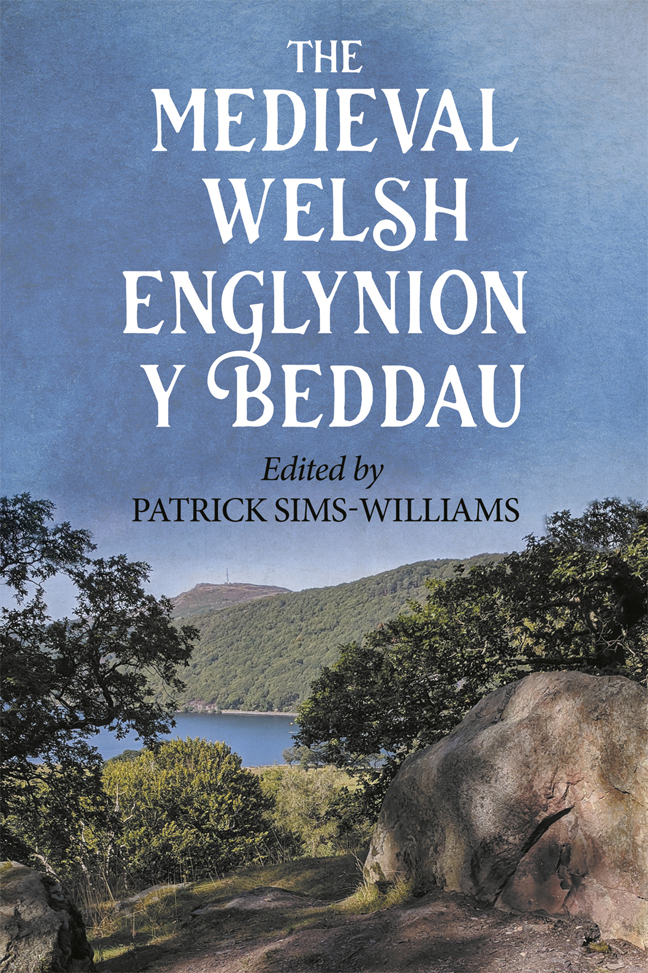 The Medieval Welsh Englynion y Beddau
The Medieval Welsh Englynion y Beddau Published online by Cambridge University Press: 02 March 2024
One page of Lhwyd’s copy of Series I and Series III from the lost manuscript of Roger Morris survives as Llanstephan 145, fol. 68. This runs from I.62 (misnumbered ‘63’) to I.72/73 (treated as one stanza, owing to a lacuna, and numbered 73) and is followed by the complete text of Series III (our MS B), numbered from 74 to 91 (but what should be numbered ‘83’ is numbered ‘82’ so that the sequence is … 82, 82, 84 …). Later bound next to it (probably by Moses Williams) as Llanstephan 145, fol. 69, is the index to both series which Lhwyd sent to William Baxter, probably in early 1708. The index was started by Lhwyd (up to H-) and was completed by Williams, his assistant. The latter’s contribution, in a neat cursive hand, is printed in italics below.
Lhwyd’s own orthography is employed in the index, with Greek letters used as follows: χ = ch; δ = dd; ƛ/Λ = ll/Ll; ρ/P = rh/Rh; τ = th. An undotted i may sometimes be iota representing ‘dark y’, and sometimes be the result of forgetting to write a dot; whichever the case, it is transcribed as ı below. There is one example of ʒ for g (s.n. Λuχ) and one ε for e (s.n. Koel).
Alongside the following transcription I give, to the right, the standard numbering of stanzas in Series I (plus the relevant Black Book text) and in Series III. Strikethrough indicates crossings out in the manuscript. On the use of bold and underlining see below.
At least two systems of numbering can be detected behind the index. The Series I numbers in the part mostly written by Lhwyd, from Aber Dyar 55 in col. 1 to Hennyn henben 72 early in col. 2, are mostly one higher than the modern numbering (marked in bold without underlining in the corresponding Black Book citations), with the exceptions of Gurien 2, Guén 3, Aren 4, Auen ab Tede 4, and Bryn Aren 4. Lhwyd originally numbered Dılan Bd. at Λan Beyno (I.4) as ‘5’. The obvious explanation for the ‘5’ is that he originally counted I.4ab and I.4d as two separate items – 4 Tede at Bryn Aren and 5 Dılan – resulting in the subsequent englynion being numbered +1; for example, Aber Guenoli and Guàƛog hír (I.7) are numbered 8 rather than 7.
To save this book to your Kindle, first ensure [email protected] is added to your Approved Personal Document E-mail List under your Personal Document Settings on the Manage Your Content and Devices page of your Amazon account. Then enter the ‘name’ part of your Kindle email address below. Find out more about saving to your Kindle.
Note you can select to save to either the @free.kindle.com or @kindle.com variations. ‘@free.kindle.com’ emails are free but can only be saved to your device when it is connected to wi-fi. ‘@kindle.com’ emails can be delivered even when you are not connected to wi-fi, but note that service fees apply.
Find out more about the Kindle Personal Document Service.
To save content items to your account, please confirm that you agree to abide by our usage policies. If this is the first time you use this feature, you will be asked to authorise Cambridge Core to connect with your account. Find out more about saving content to Dropbox.
To save content items to your account, please confirm that you agree to abide by our usage policies. If this is the first time you use this feature, you will be asked to authorise Cambridge Core to connect with your account. Find out more about saving content to Google Drive.